
Are you a Western company, brand, or individual in the tourism industry?
Are you considering promoting a tourist attraction to a Chinese audience but unsure where to begin or how to do it?
We know that venturing into a new market can be daunting, especially if it’s as expansive and unique as China.
But it doesn’t need to be.
We have created this guide to help you understand the basics of harnessing China’s number one social media app, WeChat, for tourism advertising.
Why Chinese Tourists Are Important?
Since 2013, Chinese tourists have been the biggest spenders worldwide and enjoy a diverse range of travel destinations, with Japan, the United States, and France being the top three countries visited in 2021.

The website Statista reported that “outbound tourism spending by Chinese travelers increased more than tenfold between 2006 and 2019.”
According to Time Magazine, “Chinese travelers made 155 million trips overseas, spending $277 billion—a fifth of the global total outlay by international tourists” in 2019. While the world didn’t see the return of Chinese tourists in 2023 as promised, with their absence having a huge impact on the global tourism industry, analysts still believe that everything will return to normal this year.
With this knowledge, you can be sure that there are many different reasons—and approaches—when it comes to marketing to a Chinese audience.
However, a few questions remain:
- How does a foreign company advertise a destination to someone in China?
- What are the best avenues for doing so?
- What types of destinations would they be interested in?
- What styles of trips are most popular?
- Do they differ by age?
- By region?
We will cover these questions and more in this guide.
Chinese Tourist Facts
A recent Reuters article discussed the problem of fewer people going abroad by highlighting how wealthy Chinese citizens are the main demographic traveling internationally.
The good news is that some companies mentioned fully booked European tours during the Lunar New Year.
Hopefully, this shows that perhaps the pandemic era’s hesitancy to travel abroad is slowly changing.
The types of trips being made are also experiencing a change.
Traditionally, the older generations, or people less acquainted with foreign cultures, opted for group tours.

(Source: skift.com)
An increasing number of people are beginning to prefer more independence on their trips, which could be due to the younger generation being more exposed to foreign media at home, or Western culture after studying abroad.
 (Source: skift.com)
(Source: skift.com)
What Is WeChat?
WeChat is the most popular social messaging and social media app in China, but it is much more than just an app for communication and consuming media.

It has earned the title of “super app” due to its many features and how it interacts with other apps and websites.
As you can see from the chart underneath, WeChat not only dwarfs other apps in terms of popularity but also in the amount of time Chinese citizens spend on it.
 Statistically, 78% of 16 to 64-year-olds in the country use WeChat, and 20% of those older than 55 use it.
Statistically, 78% of 16 to 64-year-olds in the country use WeChat, and 20% of those older than 55 use it.
Most of Wechat’s users do not reside in tier 1 cities (Shanghai, Beijing, Shenzhen, Guangzhou), and 40% live in tier 2 cities (e.g. Zhengzhou and Xi’an).
In terms of the distribution of WeChat users,
- 9% live in tier 1 cities,
- 23% in tier 3 cities, and
- 27% in tier 4.

(Source: skift.com)
The above data shows that social media is already the second most popular method for finding trip-related resources, and young people use apps like WeChat to plan their overseas trips.

(Source: skift.com)
Please note that WeChat has its own functions that incorporate travel websites and blogs, which we’ll cover later.
As you can see, WeChat is a big deal in China; therefore, it would be wise for any tourism company or website outside of the country interested in attracting Chinese customers to understand how WeChat works.
How to Use WeChat?
Now that we have a basic understanding of what WeChat is and the data behind it, let’s peek underneath the hood of this app to learn more.
In other articles, we go deeper into discussing the ins and outs of the app. But for now, we will focus on the basics and how to advertise a tourist attraction.
When a user first opens the app, they are greeted with the “chat” screen. Like most messaging apps, this page displays all the conversations a user has had. However, most Chinese citizens or foreigners living in China, probably see much more than simple one-on-one or group chats on this page.
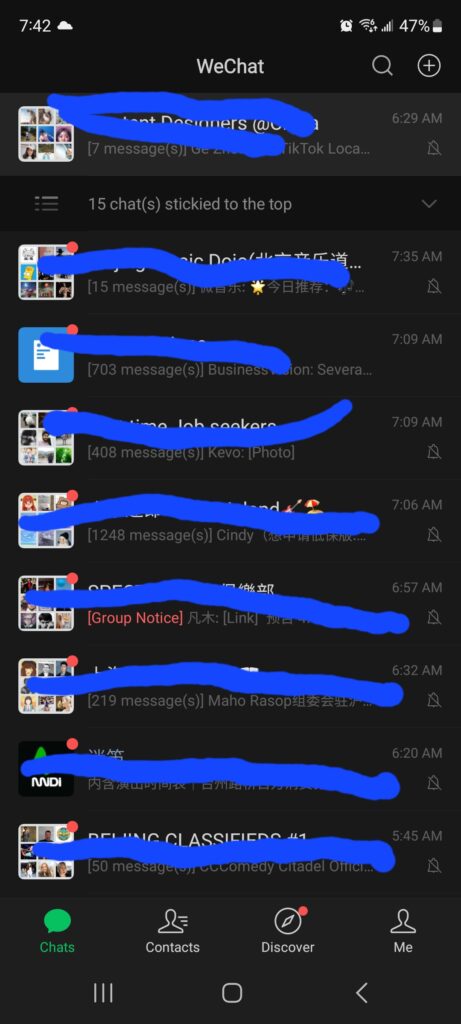
Let’s start by connecting WeChat to something you already know: Facebook and WhatsApp.
If you have ever used WhatsApp, you may be aware of the “updates” page, which allows a user to follow companies and other organizations to get news and regular updates.
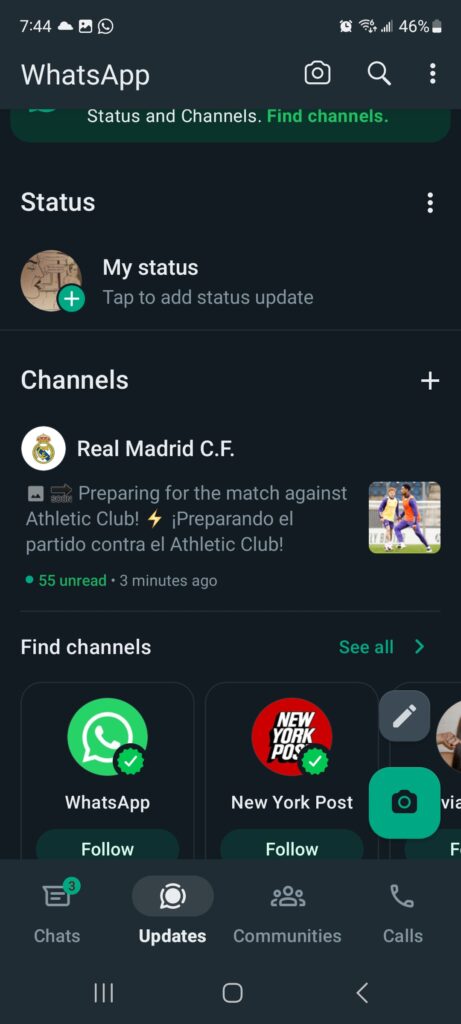
This is quite different from something like Facebook.
When a user follows a channel on WhatsApp, its shared content is not added to a main “Home Feed.” Instead, a followed channel remains on the “Updates” interface, and a user must click on each channel separately to see any updates.

If a user wishes to find an account or information related to tourism, they can click the “Search” button at the top right of the app’s interface.
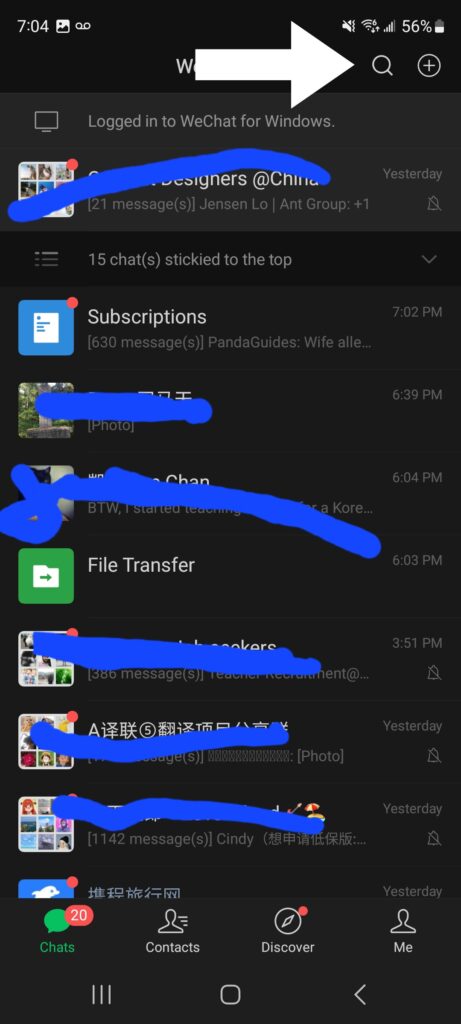
It’s important to point out that users can’t do this in the desktop version of WeChat. This is not a problem, however, since China prefers phones over desktop computers (compared to North America or Western Europe).
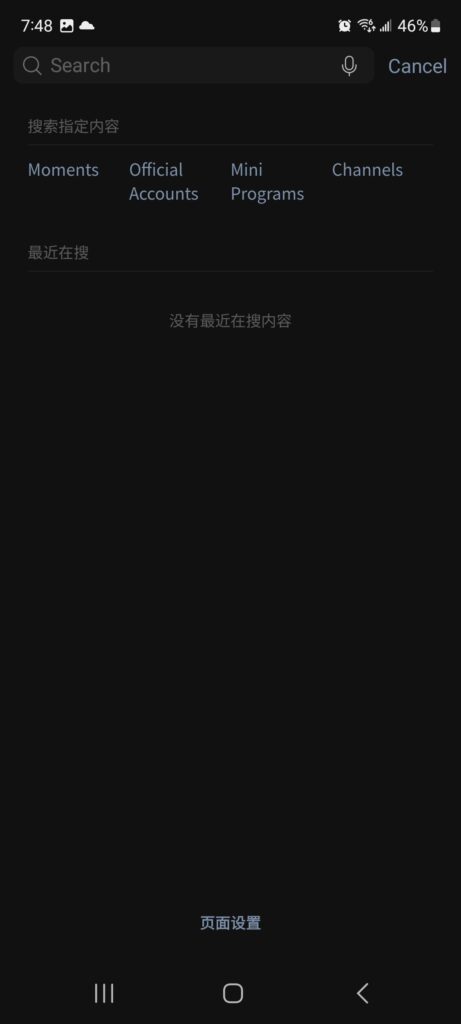
Once they have done this, they’ll see a few options: Moments, Official Accounts, Mini-Programs, and Channels. For now, let’s ignore the Moments feature and focus on the last three.
WeChat Official Accounts
If a user selects “Official Accounts,” they will be given another search bar.
Fortunately, WeChat has some accounts in English due to the number of foreigners living in China.
Since the purpose of this article today is tourism, let’s search for the topic “travel.”
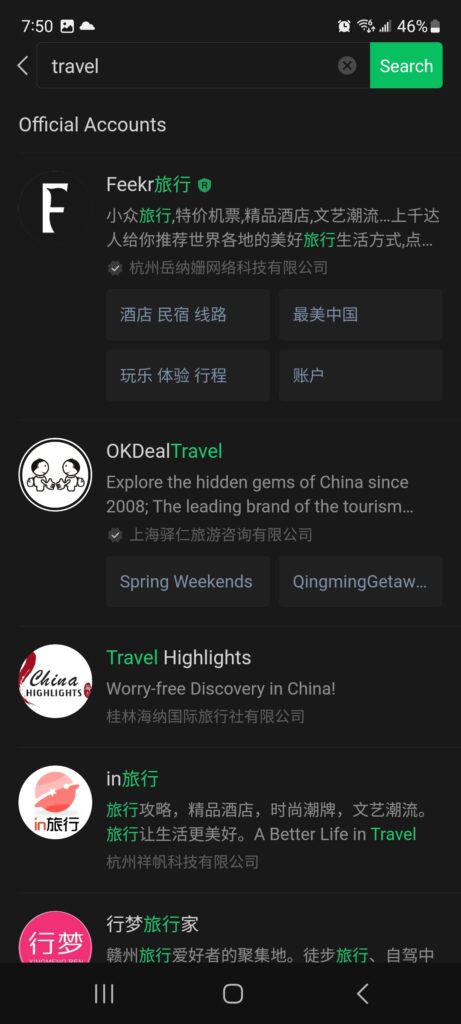
This brings up a list of options just like the “Search” function in WhatsApp or Facebook. Now, let’s click on an English-language account to learn more about Official Accounts.
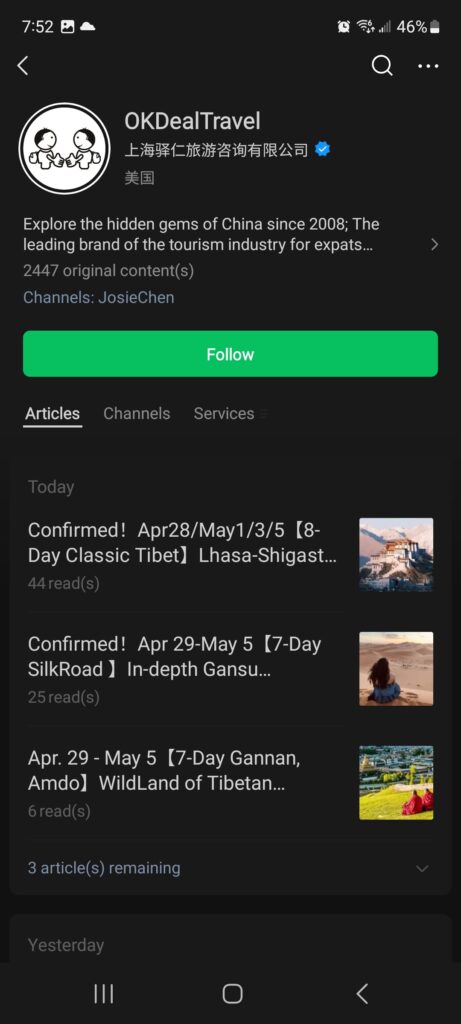
Above is a screenshot of OKDealTravel’s account.
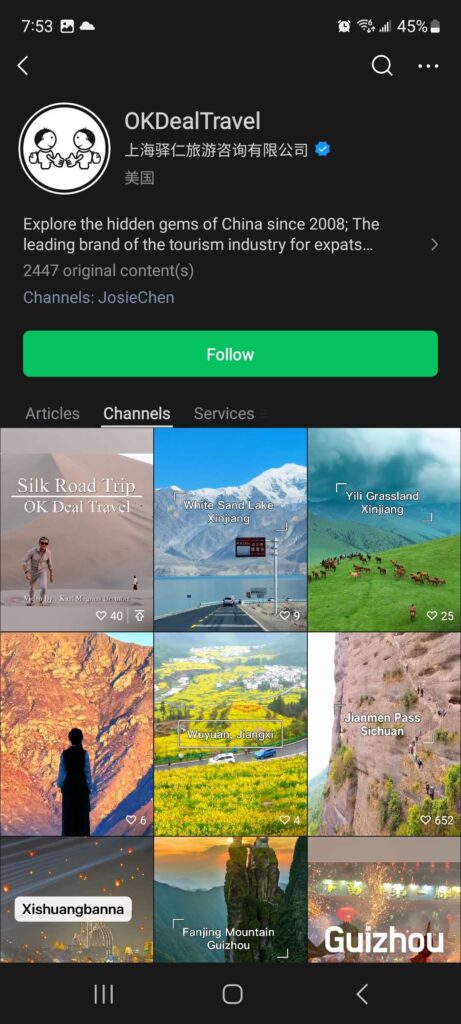
The Chinese characters just below the title are the name of the company that runs it, accompanied by a short description of the channel’s content and a large “Follow” button.
After this, a user can select from three different options:
1- Articles are straightforward. These particular headlines are all about upcoming trips that foreigners living in China can join to enjoy their days off.
2- Channels are similar to something you would see on TikTok or Instagram. Remember, TikTok came from China. If TikTok is a tour de force in the West, you can bet it’s the same and more in the largest country in East Asia.
Remember, these videos aren’t for YouTube where people often prefer longer-form content.
For Official Accounts like this one, keeping the content short and sweet is the most important thing to remember.
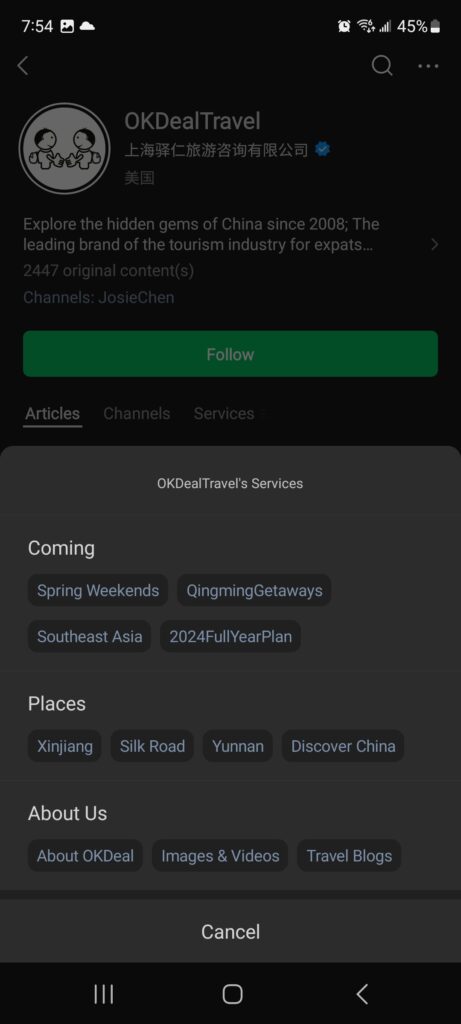
3- Services. Companies have a lot of freedom in what sub-options they can put in this tab. As shown in the above screenshot, companies may prefer this tab to take users to other websites. As the name suggests, this option is also for advertising what services a company can offer a customer.
OKDealTravel has chosen to advertise the places they work with.
Let’s click on “Silk Road” to explore further.
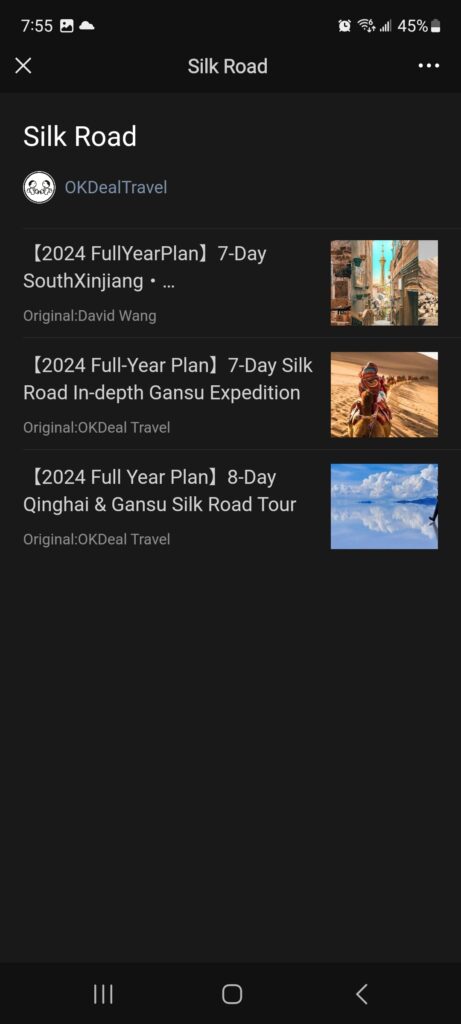
Once a user has done this, the next interface displays a list of tour options to choose from, and a user can select one of these to learn more about the tour’s contents and pricing.
Note that while the appearance in English here may seem a little cramped, the case would not be the same in Chinese since it is a language that requires less space.
One of the most important things to remember about Official Accounts is that once a user follows one, they will receive messages in their main chat interface from these Official Accounts.
This is possibly the best way for companies to keep their followers aware of their services and why it is crucial for them to create new articles regularly.
Some companies like to hold livestreams on their Official Accounts.
These livestreams allow customers a chance to enter lotteries or get discounts for holidays. Live streaming is popular in the West, but it often takes on an entirely different level in China, and the same goes for lotteries.
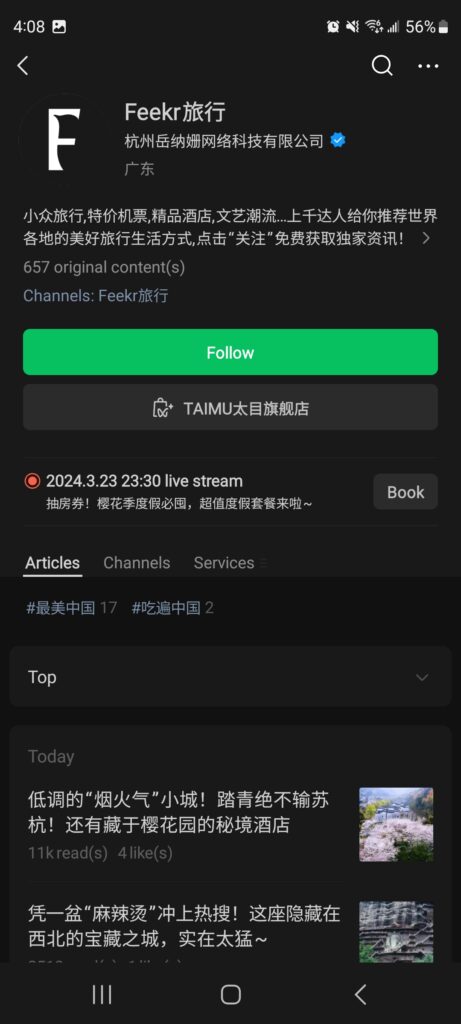
WeChat Mini-Programs
In China, most people are used to using WeChat as a one-stop location for their needs (but that’s not to say there aren’t other options).
Although the mini-programs appear next to Official Accounts in the search results, they are far more complicated. This does not make them less useful, however.
In its simplest form, a mini-program is an app within an app, and in the English-speaking world, a person usually needs to go to the Google Store to download a new app.

But unlike apps downloaded from Google, WeChat’s mini-programs erase the hassle of having individual apps cluttering a phone’s screen.
On that note, let’s use the “Search” function on WeChat to search for some mini-programs as examples. As we did with Official Accounts, we can search “travel.”
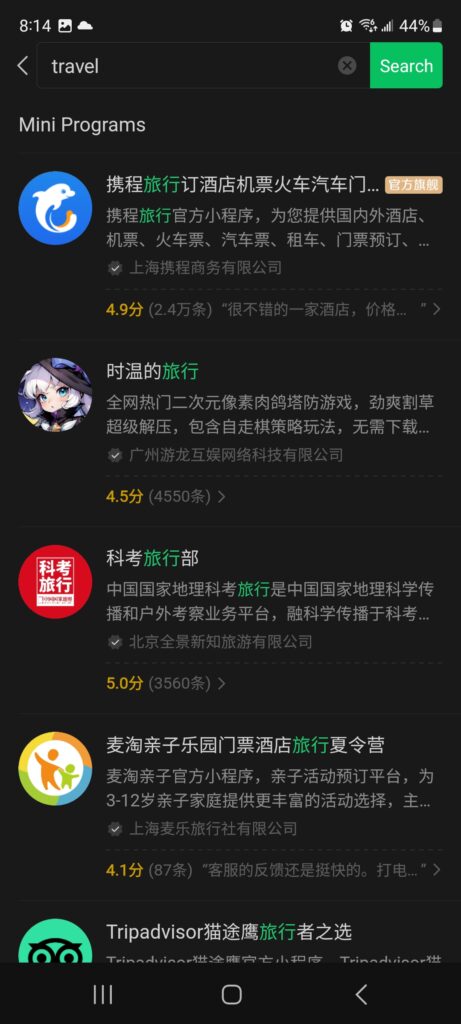
All of these search results may be in Chinese, but the well-known Tripadvisor logo is recognizable at the bottom of the options.
Let’s click on Tripadvisor to see if its mini-program is different from what we have in the English-speaking world.
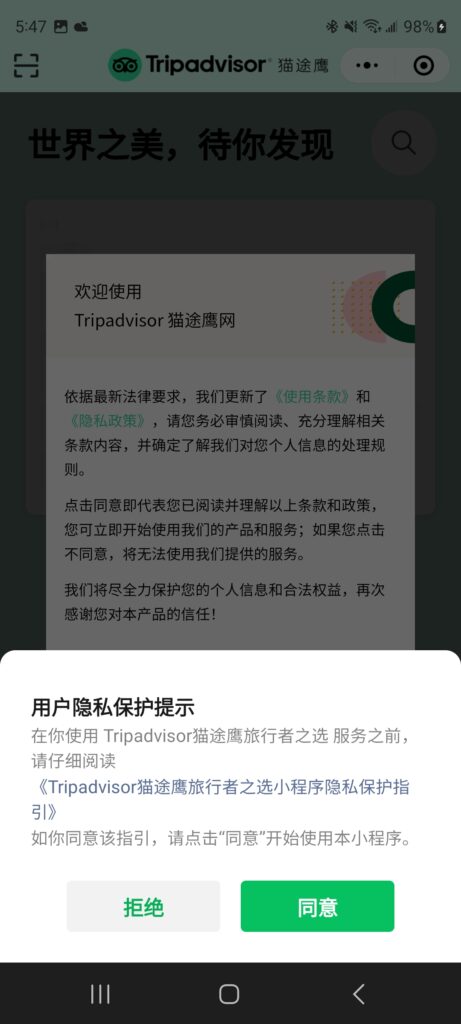
When we open Tripadvisor’s mini-program, we are greeted by a user agreement and privacy policy page.
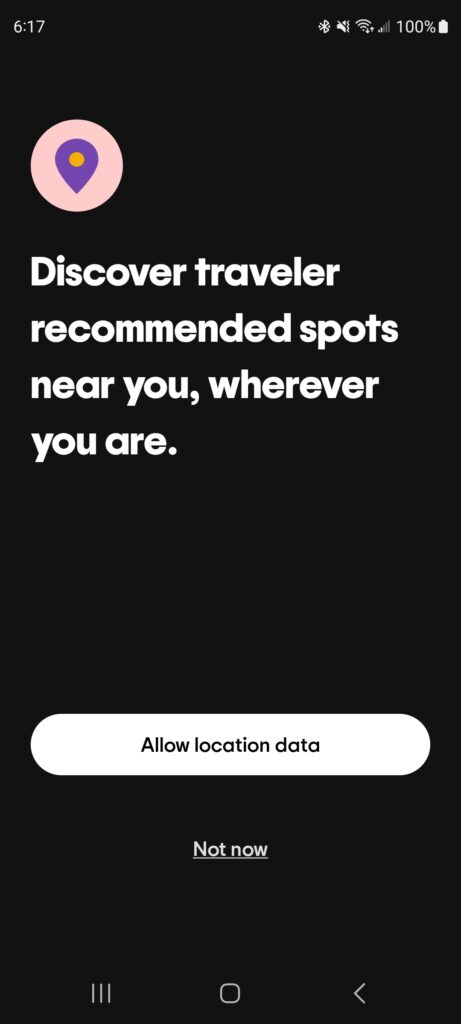
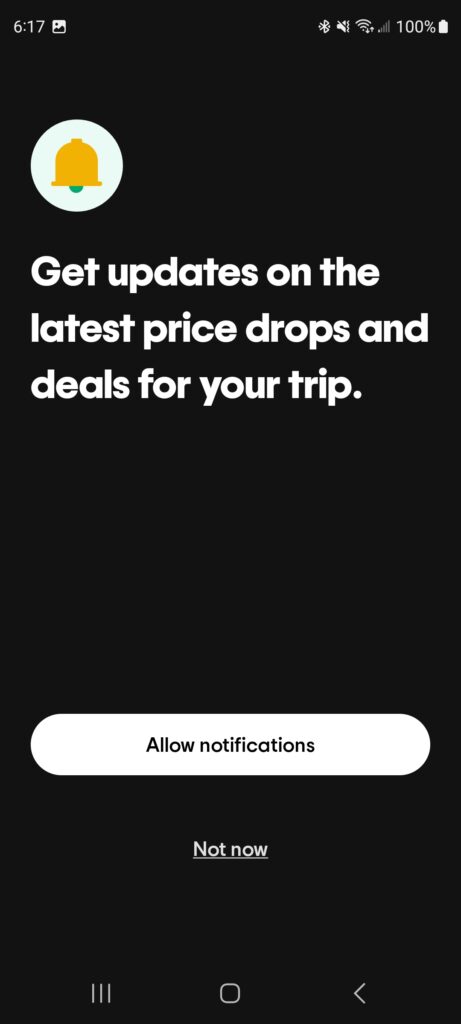
While the English-language version is not identical to this, it does ask users if they wish to share their location and receive notifications.
Below is a screenshot of both.
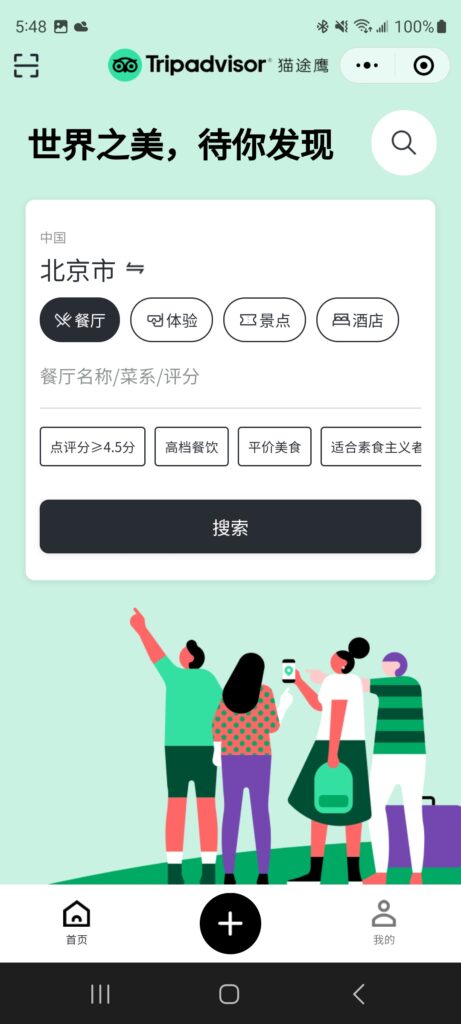
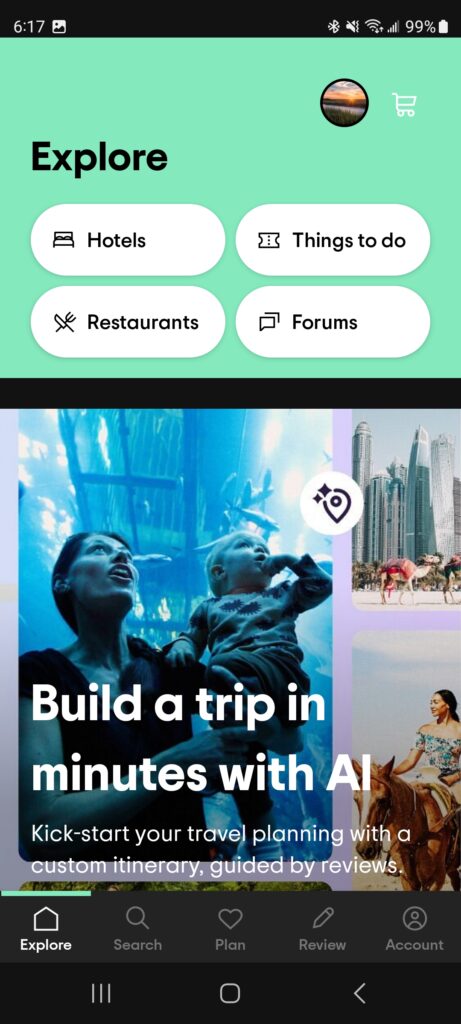
Although these two interfaces are in different languages, there are a lot of similarities.
For example, the background retains the same green color Tripadvisor uses for its branding.
While this may not seem like a big difference, colors in marketing can sometimes have different meanings depending on the culture, but when it comes to companies that exist all over the world—consistency is crucial.
Even though the Chinese mini-program appears a little more simplistic compared to the American app, it still contains most of the same features.
As we look over some aspects of WeChat in this article, we will highlight some of the differences in UX design encountered in China. This may be important information if your organization is considering creating a mini-program for WeChat.
To get started on this, it may be useful to see how other non-English speaking companies have made use of WeChat’s mini-programs for tourism purposes.
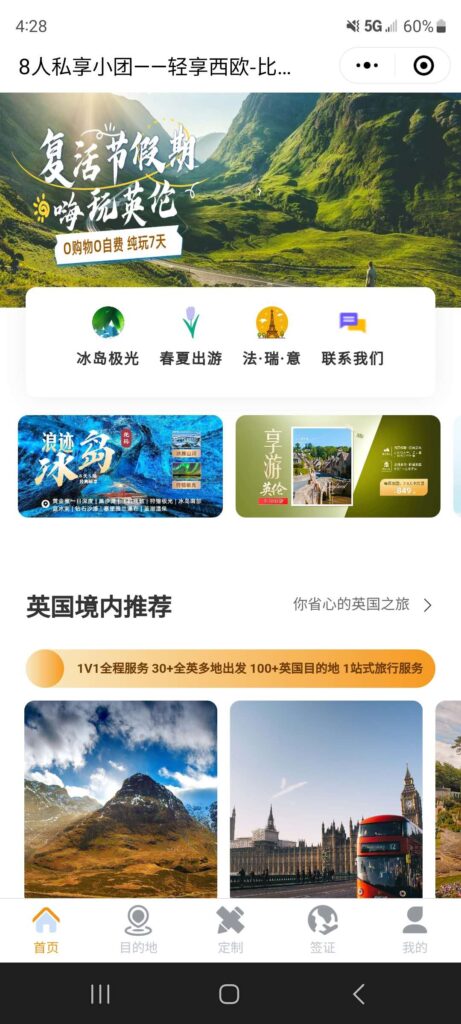
The above interface comes from one of the other top mini-programs that appear after searching for “Travel.” This mini-program is called 走走旅游网 or ZouZou Travel. 走 (zou) here refers to walking or going away.
If you open the website link, you can see that the interface is very similar to the one being used on WeChat. In comparison to the Tripadvisor app, both have busier screens. For example, there are more buttons, and this may appear strange to a native English speaker.
Chinese companies coming to the United States, Canada, or the United Kingdom sometimes struggle to realize that their app designs may appear messy to a Western audience.
With this in mind, your company may want to consult UI writers and designers in China to help localize your mini-program, which NMG can help you with.
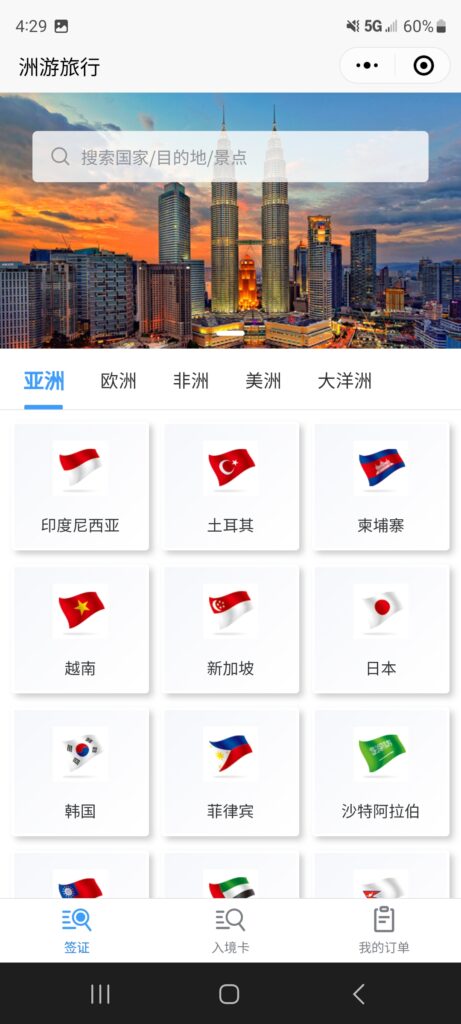
The next mini-program we will examine is called 洲游旅行 or Zhouyou Travel. 洲 means “continent” and 游 means “to travel.” If we look at their website, we can see what was mentioned earlier in this article: websites are not as important in China compared to English-speaking countries.
Notice how this website is just a basic page with no information about the company. This demonstrates WeChat’s significance to any tourism company wishing to do business in China.
Again, the above interface demonstrates app developers’ preference for color and images.
Tripadvisor appears to have tried to keep the general appearance of its international app in China, and there isn’t anything wrong with this.
However, your own company may want to create a mini-program in line with your global branding or develop something more localized for the Chinese market.
Something between the two is also an option.
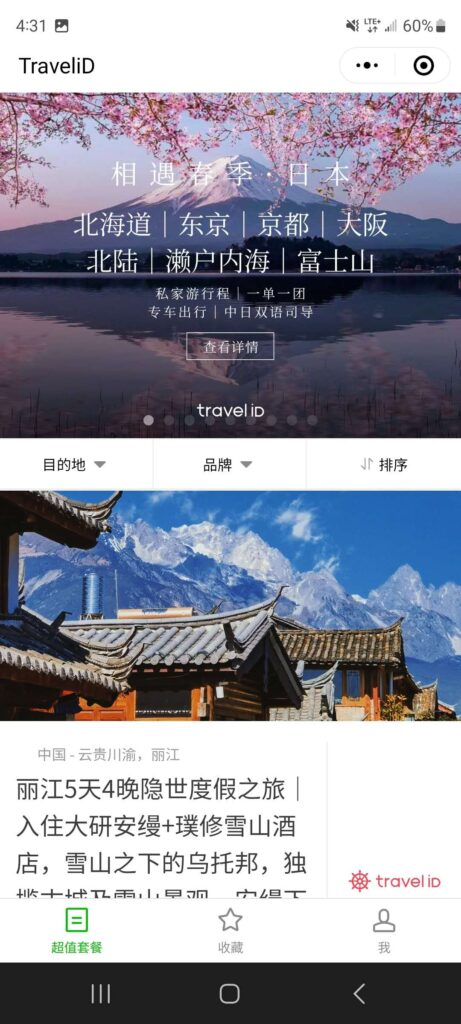
Don’t take everything we’ve discussed about design as gospel. As we can see from the above screenshot, local Chinese apps sometimes prefer minimalism.
This particular mini-program from TravelID is more focused on showing Chinese customers a potential travel destination straight away. It gets right to the point by providing eye-catching photos of Japan and information about a few trip packages.
Now that we have gone over a few of the basics of WeChat mini-programs and shared a few related to tourism, you may be wondering how a user can find your company’s mini-program again.
To do this, a user can return to WeChat’s home screen.
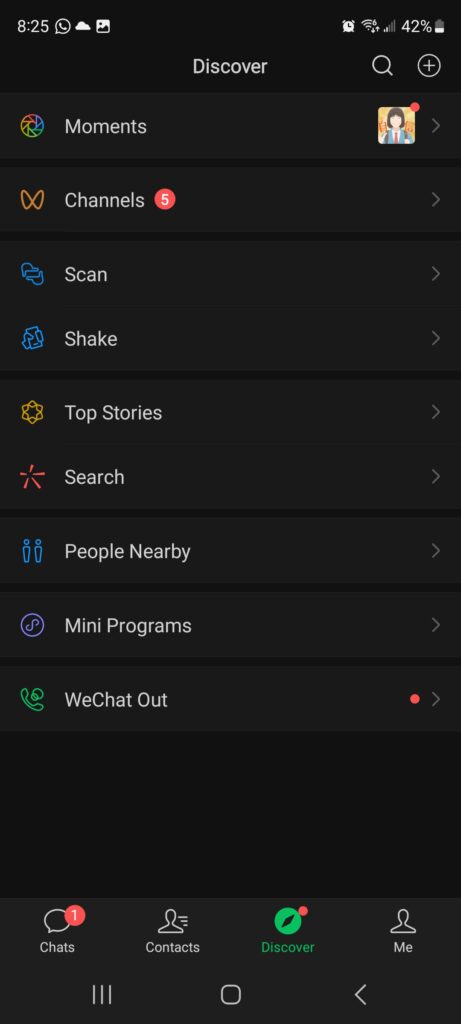
As you can see from the above, a user can click on the “Discover” button at the bottom of WeChat’s main interface to get a range of options, one of them being the mini-programs.
If we select this, the below screen will come up.
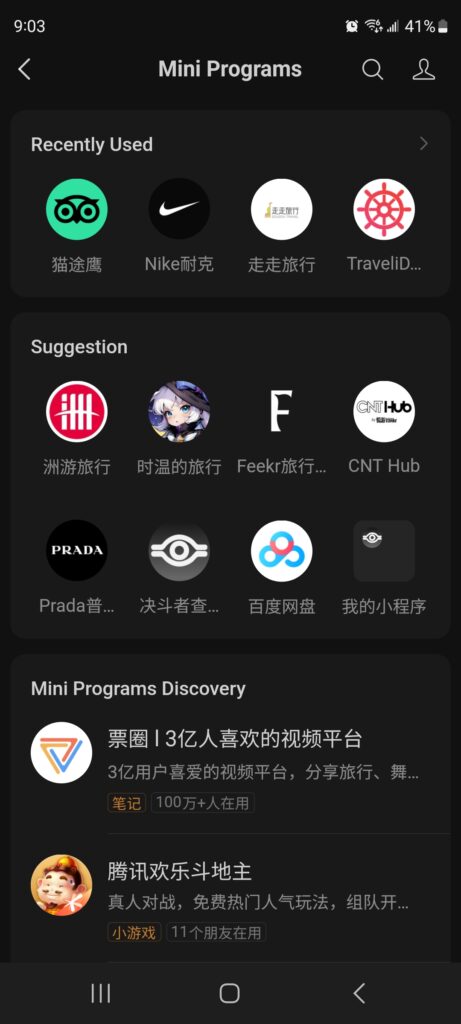
The mini-programs interface shows what apps a user has already used, as well as suggestions based on what a user has already looked for. In this way, mini-programs are not exactly like apps in English-speaking countries.
However, this does not mean it’s a bad thing.
Many phone apps in North America and Europe go unused for a while, using up space on a person’s device.
Channels
We’ve already touched on this feature in the Official Accounts tab, and companies may choose to create a channel or connect one to an Official Account.
The examples below demonstrate what this looks like on WeChat.
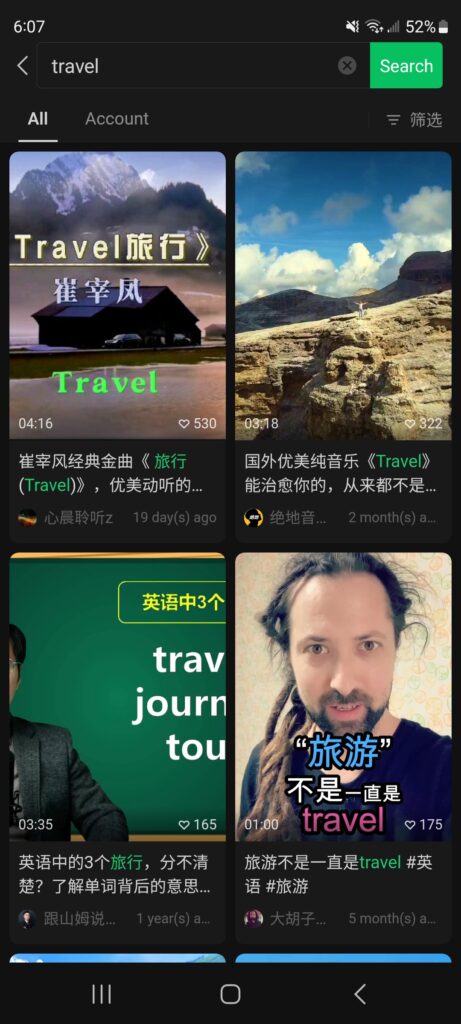
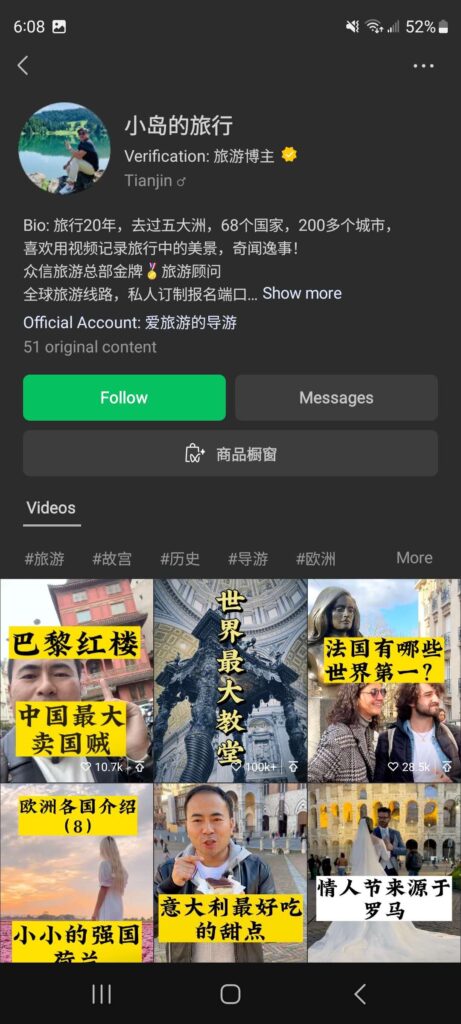
Services
Besides the options presented by the “Search” function, there is one other choice companies may choose to use.
To see this, we can go to the “Me” button at the bottom of WeChat’s main interface and select “Services.”
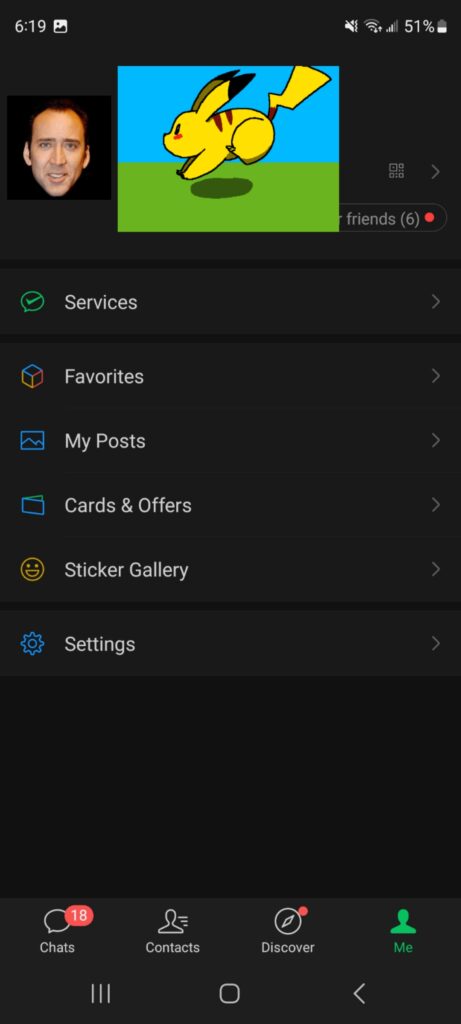
Once we do this, we are presented with the following screen.
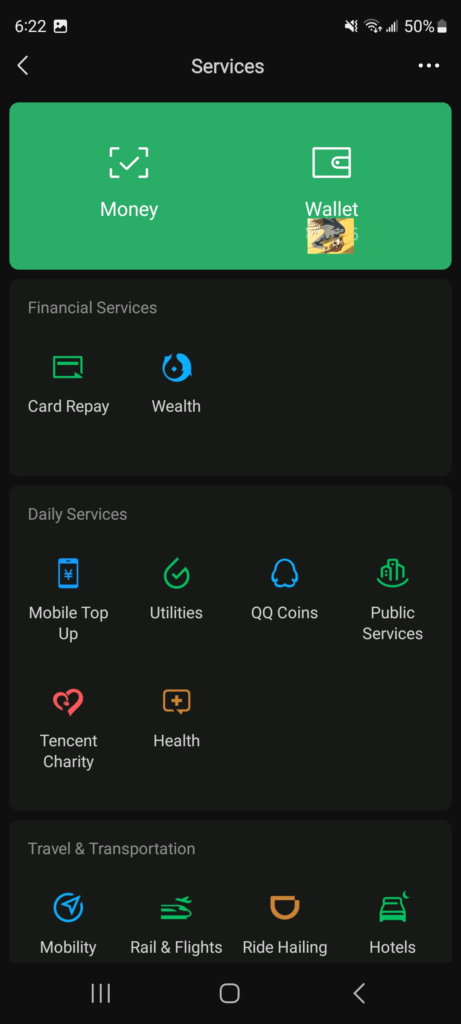
This interface is filled with different icons, but we will be focusing on the “Hotels” function, and this button takes the user to a new interface run by the company Tongcheng Travel (again a very busy interface).
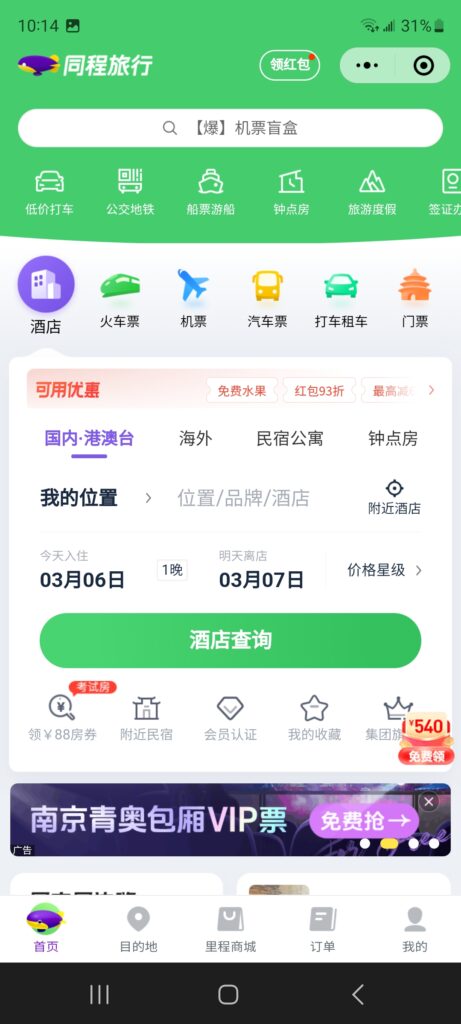
Most of the options on this screen refer to searching and booking hotels and trips, but there is also the option 旅游度假, which roughly translates to “go on a holiday.”
If we select this, it will take us to an interface where users can find travel consultants, buy travel packages, book cruises, and get suggestions based on what locations are trending.
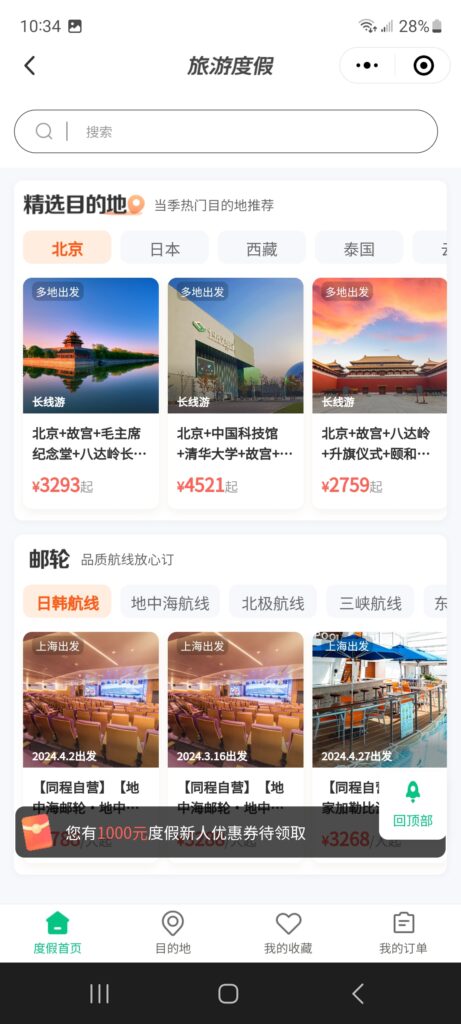
You may wish to use this function of WeChat if you’re aiming at older Chinese users. This option is a little easier to find than the previous options and requires less searching.
Advantages of Being a Western Brand

Now, you may be wondering, there seem to be a lot of tourism companies already making use of WeChat—how can I compete?
As you saw from the examples used in this guide—with the exception of Tripadvisor—most of the companies were Chinese brands. Therefore, you may be worried that these brands know how to connect with local users better than their Western counterparts.
But Chinese users, like the citizens of many countries, trust first-hand sources on events more than anything else…especially when it comes to tourism.
Contact Us
Hopefully, you now know your way around WeChat, its different features and functions, and how these could be used to promote a tourist attraction to a Chinese audience.
However, if you want to secure that trending spot on Chinese social media and be in the must-see section of every traveling tourist’s to-do list—you’re going to need great content.
But that’s a topic for a separate post.
If you have any questions about WeChat or how to market your brand or business in China, you can set up a free consultation here.
For more information on WeChat and Chinese marketing in general, see our China Digital Marketing 101 page.
